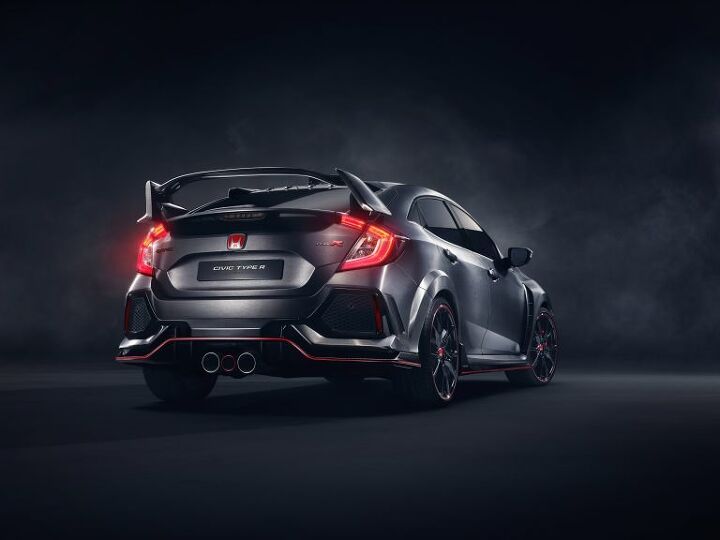Honda Civic Type R Prototype: The Wing You've Been Waiting For

Honda has provided a glimpse of the U.S.-bound Civic Type R at the Paris Auto Show, albeit in concept form (though the automaker prefers the near-production term “prototype”).
This Type R — designed in Japan, built in the UK, and destined (at last) for America — uses the Civic Hatchback as a canvas, then adds every visual performance indicator the automaker could get its hands on. Reportedly, it will have the power to back up its looks.
The Type R is rumored to pack 340 horsepower, and will arrive next year alongside the lesser Civic Si. For now, Honda is keeping powertrain details under wraps.
Engine speculation aside, Honda gave us plenty to look at. (Some might argue too much.) The Type R adds visual aggression wherever it can: new outboard ducts added to the front fascia, smoked headlight lenses, front hood scoop and spoiler, carbon fiber side skirts, extended wheel arches, 20-inch “piano black” alloy wheels wearing 245 width rubber, and that all-important rear wing.
Like other Civics, the Type R sports center-mounted tailpipes, but adds a third, painted outlet. Honda isn’t dishing details on the third pipe or the hood scoop. It’s a safe bet that they aren’t there just for show.
While this Type R is a prototype, the production model likely won’t diverge too much from the vehicle seen here. The first next-generation Type Rs to roll off the Swindon, UK assembly line arrive at European dealers in the second half of 2017. Honda hasn’t said when long-deprived U.S. fans can expect theirs.

More by Steph Willems
Latest Car Reviews
Read moreLatest Product Reviews
Read moreRecent Comments
- B-BodyBuick84 Not afraid of AV's as I highly doubt they will ever be %100 viable for our roads. Stop-and-go downtown city or rush hour highway traffic? I can see that, but otherwise there's simply too many variables. Bad weather conditions, faded road lines or markings, reflective surfaces with glare, etc. There's also the issue of cultural norms. About a decade ago there was actually an online test called 'The Morality Machine' one could do online where you were in control of an AV and choose what action to take when a crash was inevitable. I think something like 2.5 million people across the world participated? For example, do you hit and most likely kill the elderly couple strolling across the crosswalk or crash the vehicle into a cement barrier and almost certainly cause the death of the vehicle occupants? What if it's a parent and child? In N. America 98% of people choose to hit the elderly couple and save themselves while in Asia, the exact opposite happened where 98% choose to hit the parent and child. Why? Cultural differences. Asia puts a lot of emphasis on respecting their elderly while N. America has a culture of 'save/ protect the children'. Are these AV's going to respect that culture? Is a VW Jetta or Buick Envision AV going to have different programming depending on whether it's sold in Canada or Taiwan? how's that going to effect legislation and legal battles when a crash inevitibly does happen? These are the true barriers to mass AV adoption, and in the 10 years since that test came out, there has been zero answers or progress on this matter. So no, I'm not afraid of AV's simply because with the exception of a few specific situations, most avenues are going to prove to be a dead-end for automakers.
- Mike Bradley Autonomous cars were developed in Silicon Valley. For new products there, the standard business plan is to put a barely-functioning product on the market right away and wait for the early-adopter customers to find the flaws. That's exactly what's happened. Detroit's plan is pretty much the opposite, but Detroit isn't developing this product. That's why dealers, for instance, haven't been trained in the cars.
- Dartman https://apnews.com/article/artificial-intelligence-fighter-jets-air-force-6a1100c96a73ca9b7f41cbd6a2753fdaAutonomous/Ai is here now. The question is implementation and acceptance.
- FreedMike If Dodge were smart - and I don't think they are - they'd spend their money refreshing and reworking the Durango (which I think is entering model year 3,221), versus going down the same "stuff 'em full of motor and give 'em cool new paint options" path. That's the approach they used with the Charger and Challenger, and both those models are dead. The Durango is still a strong product in a strong market; why not keep it fresher?
- Bill Wade I was driving a new Subaru a few weeks ago on I-10 near Tucson and it suddenly decided to slam on the brakes from a tumbleweed blowing across the highway. I just about had a heart attack while it nearly threw my mom through the windshield and dumped our grocery bags all over the place. It seems like a bad idea to me, the tech isn't ready.



































Comments
Join the conversation
The crab pincher tail-lights are not growing on me.
It's got a manual transmission! I could do without the rest of it. :(